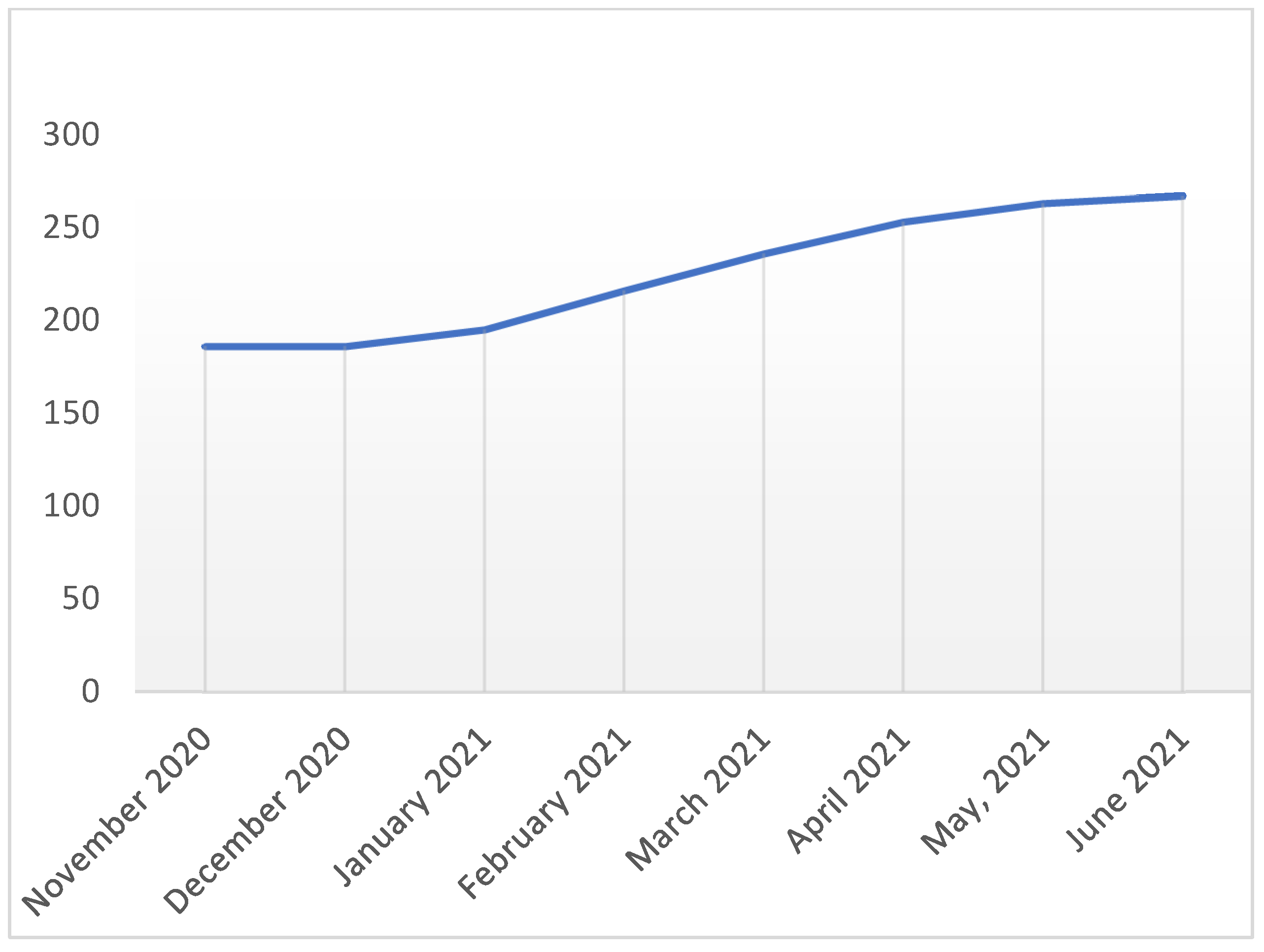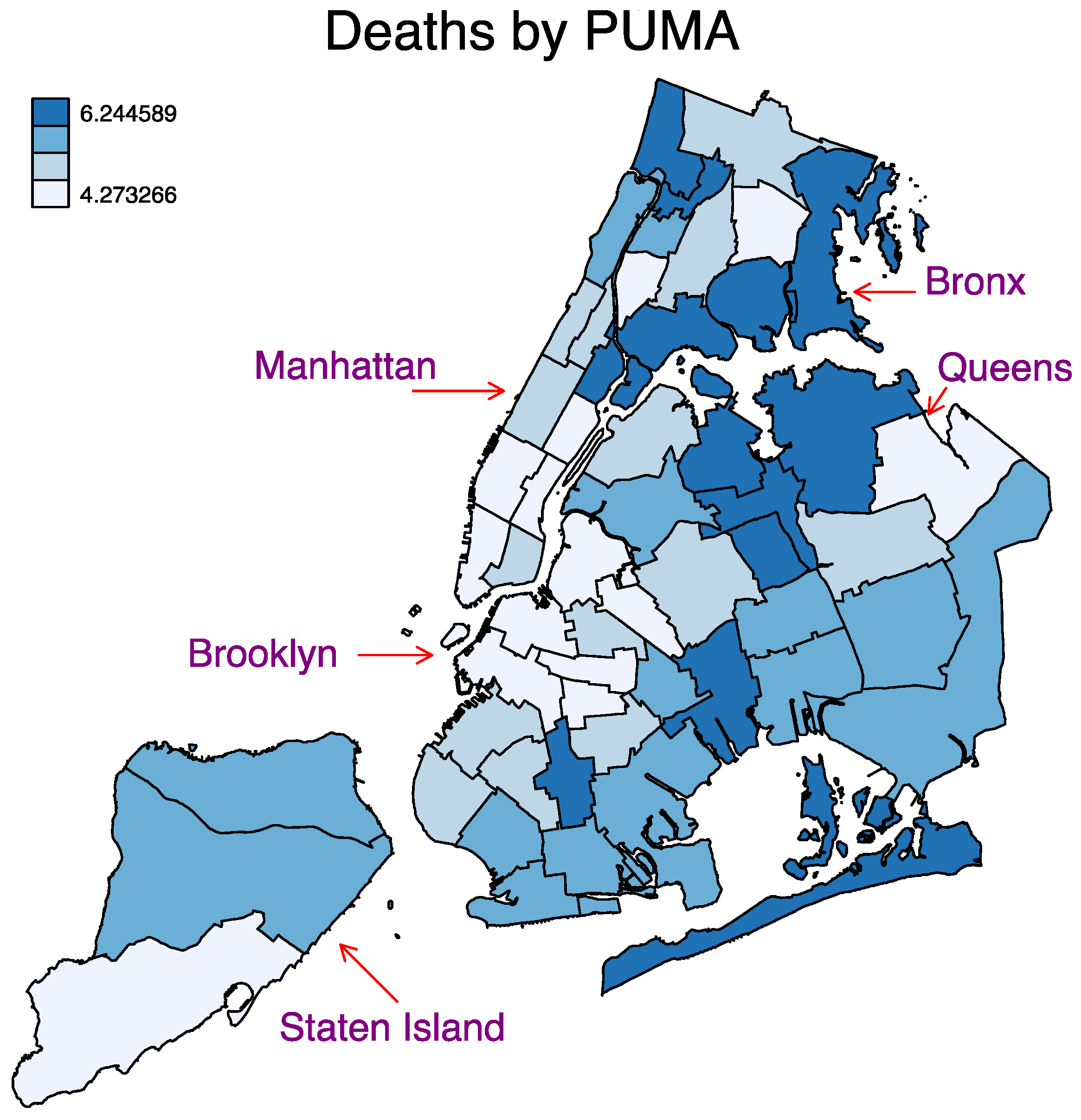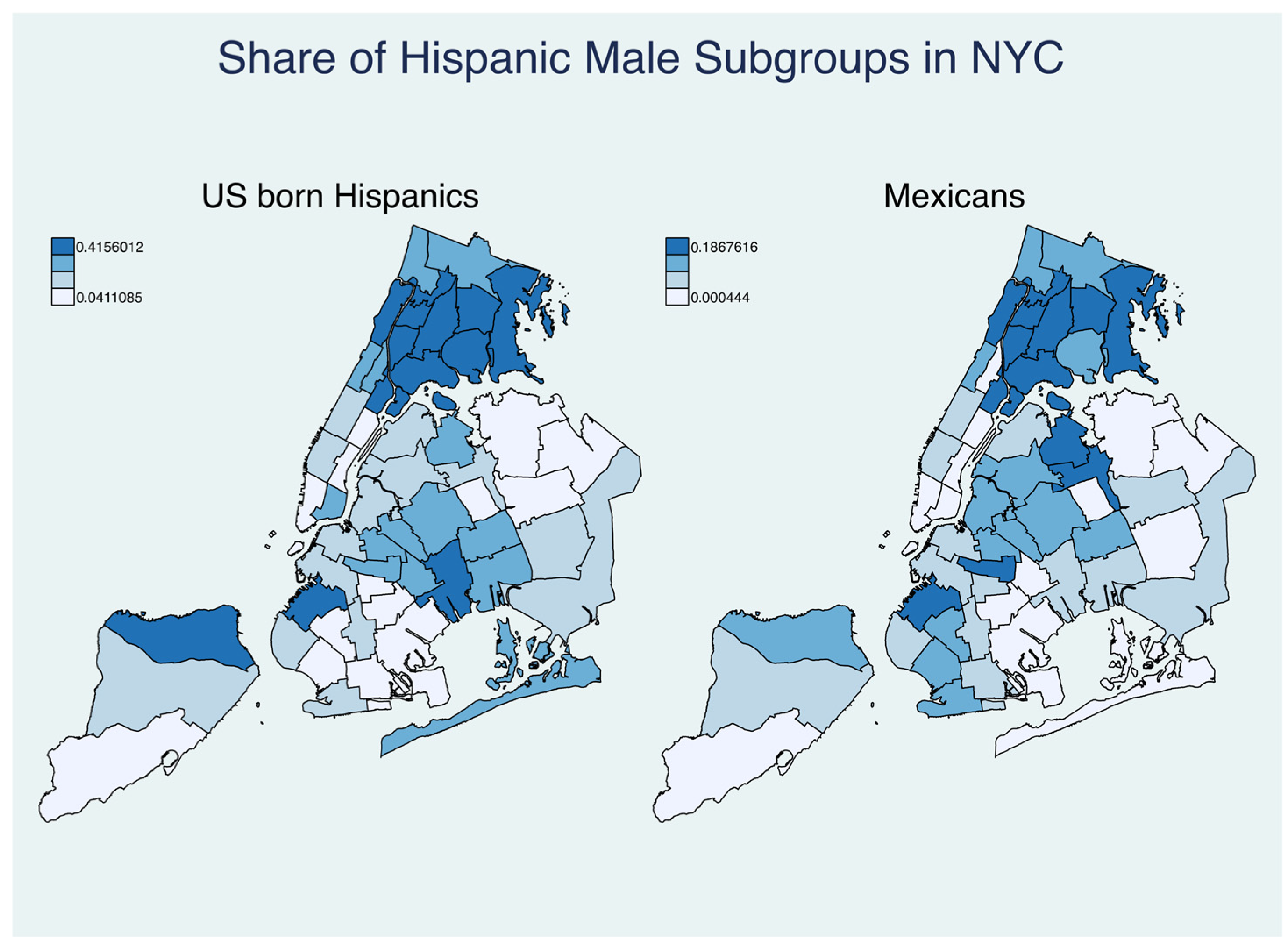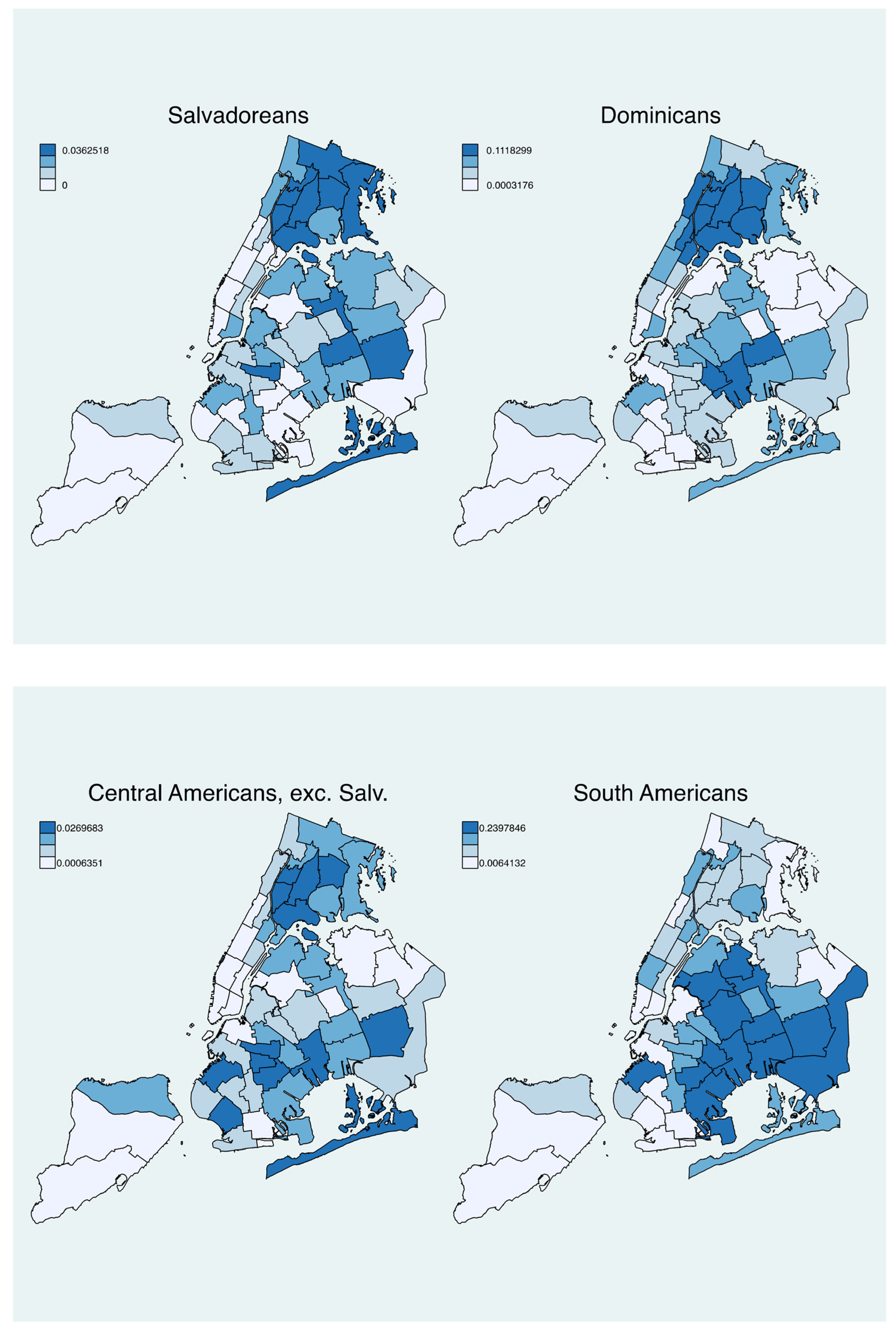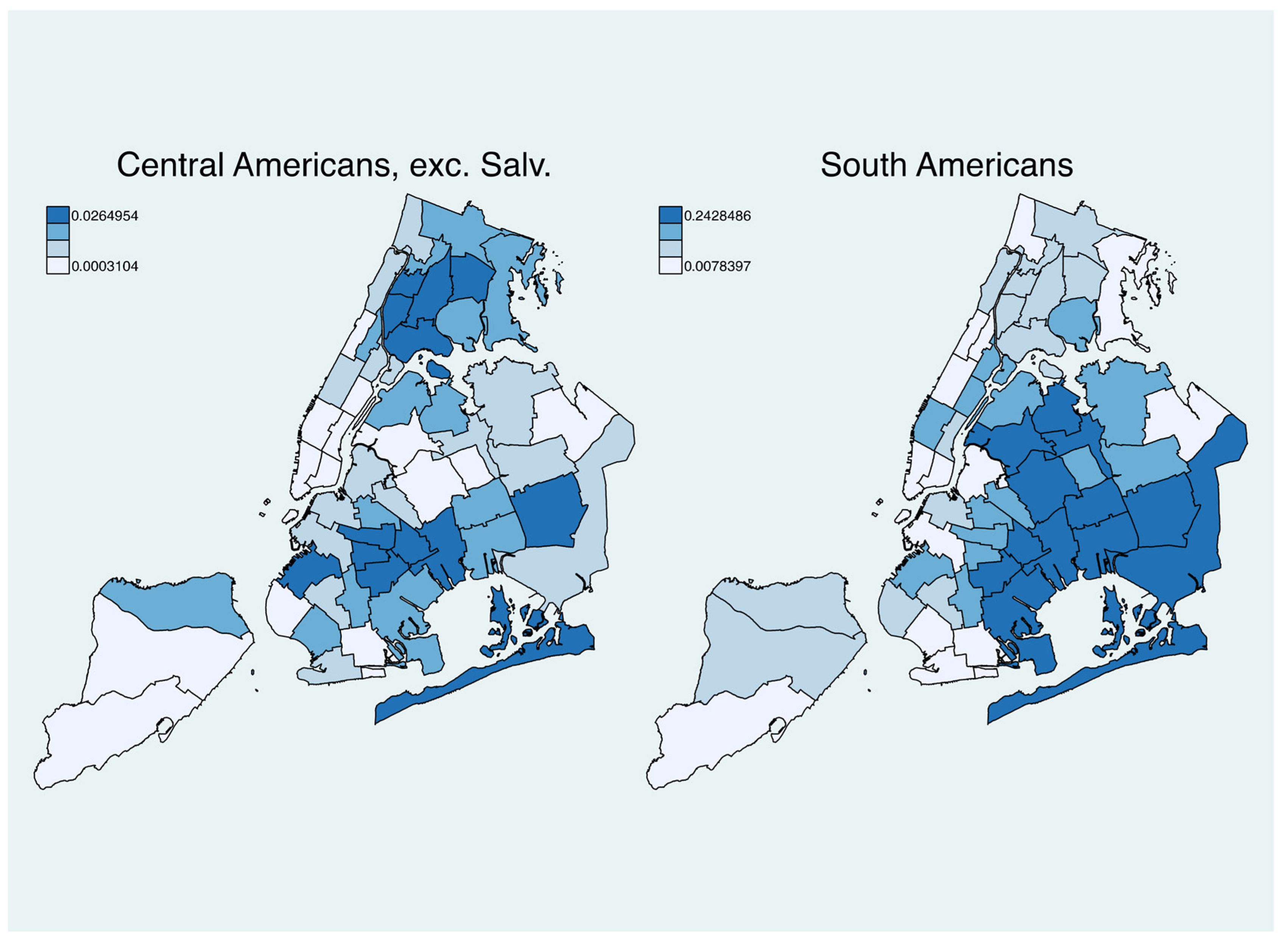3.1. Estimations for Men and Women
Table 3 presents the results for the correlation between the Hispanic subgroups and the change in death rates at the PUMA level for men. The first part of
Table 3 shows estimations with no control variables, no spatial correlations, and for the changes in the number of monthly deaths. A positive correlation is observed for US-born Hispanics and Mexicans, but it is not found among any of the other Hispanic subgroups. This finding coincides in marking heterogeneity in health (
Jerant et al. 2008) and life expectancy (
Garcia et al. 2018) outcomes of different Hispanic subgroups.
The second part of
Table 3 shows the estimations with control variables, spatial correlations for the changes in the number of monthly deaths at the PUMA level. The positive correlation vanishes for US-born Hispanics, which implies that, once the characteristics of the PUMA are taken into consideration, the group shows signs of assimilation. This implies that, for this group, macro-level factors explain their differential health outcomes, something predicted by RPIF (
Burgos et al. 2017). In the case of Mexican men, the direct effect is positive and significant, but the total effect is not. This implies that, for Mexican men, the indirect effect acts as a protective factor. Then, the PUMA where Mexicans live is a risk factor, as the downward assimilation hypothesis argues (
Portes and Zhou 1993), but such an effect is counteracted by the adjacent PUMAs. This counteracting effect has not been predicted by RPIF and, as such, represents the complexity of the effects of the macro structure on immigrants. Further research is needed to better understand these complex effects. In the case of Dominican men, a positive and significant correlation emerges, which is explained both by the direct and indirect effects. These results imply that, for Dominican men, controlling for the characteristics of the PUMA and the spatial correlation reveals a state of vulnerability; this result is consistent with the downward assimilation hypothesis (
Portes and Zhou 1993). In the case of other foreign-born Hispanics, a positive and significant effect is found for the direct and total effects but not for the indirect effect. These results suggest that the macro structure ends up being a risk factor for this group, which reveals a state of downward assimilation for this Hispanic subgroup (
Portes and Zhou 1993). In the case of Salvadoreans and South Americans, no positive association is found between deaths and their share, which would suggest successful assimilation for those groups (
Gordon 1964). In the case of Central Americans excluding Salvadoreans, a negative direct effect is found, while a nonsignificant total effect is observed. This would imply that the indirect effect generates an elimination of the positive effects observed at the PUMA level. The positive effect found on health would suggest an upward assimilation generated by ethnic concentration (
Portes and Zhou 1993). However, such a positive effect on health is eliminated by the adjacent PUMAs. As explained before, the effect of the adjacent PUMAs is not considered in RPIF and highlights the complexity of the macro-level effects. Further research is needed to better understand these results. Overall, these results imply that the spatial concentration effects are heterogeneous, as the Segmented Assimilation Theory claims (
Portes and Zhou 1993), since different Hispanic subgroups living in the same geographic area present different patterns of assimilation. The results also highlight the effects of the macro structure on the health outcomes, something predicted by RPIF (
Burgos et al. 2017), and reveal the complexity of the effect of the macro structure.
Table 4 presents the results for the correlation between the Hispanic subgroups and the changes in death rates at the PUMA level for women. The first part of
Table 4 shows no significant correlation is found for any Hispanic subgroup. The second part of
Table 4 reveals that, for Mexican and Salvadorean women, once the estimation controls for the characteristics of the PUMA and the spatial correlation, positive and significant direct, indirect, and total effects emerge. The existence of a positive relation between the Hispanic subgroup shares and deaths indicates that there is evidence of downward assimilation for Mexican and Salvadorean women (
Portes and Zhou 1993). No significant results are observed for other women, which would suggest that other Hispanic female subgroups are integrated in a general sense (
Gordon 1964).
Overall, these results show the existence of heterogeneity of the results by Hispanic group and by gender, even though they face the same geographic location, as predicted by Segmented Assimilation Theory (
Portes and Zhou 1993). These results also highlight the importance of macro-level factors, as RPIF predicts (
Burgos et al. 2017). The complexity of the macro-level factors was observed among men, but it was not observed among women, which only highlights the need for further research to understand the origins for this complexity in the macro-level factors.
3.2. Using Different Subsamples: Time in the US, Citizenship, Employment Status, Health Insurance, Singlehood, and Household Headship
Different arguments have been given for the existence of a correlation between deaths and the Hispanic share. So far, this paper has shown the heterogeneity in such results and the importance of Segmented Assimilation Theory and RPIF (
Burgos et al. 2017) in helping to understand such heterogeneity. This section explores if the different explanations for the existence of a correlation between deaths and the Hispanic share influence the results obtained so far.
Table 5 shows the results for subsamples generated for individuals that have arrived in the US since the year 2000 and for individuals that are US citizens. Time of arrival to the US has been argued to be correlated with health status, according to the hypothesis of the weathering process (
Garcia et al. 2021b), which argues that immigrants with less time in the US should have better health outcomes. In the case of citizenship, the argument is that it should be related positively to health outcomes because of its correlation with access to health insurance and medical services not being available for non-citizens. These results also include as a control variable the share of doctors in the PUMAs, which, in principle, is a control variable for the proximity to health professionals.
A note of clarification needs to be established regarding US-born Hispanics. In the ACS 5% sample, it is possible to identify the US state or territory where the individual was born. Consequently, individuals born in Puerto Rico, for example, are counted as Hispanics born in US territories but could have recently immigrated to New York City.
Table 5 shows that, for US-born Hispanic men, the direct effect is positive and significant. This implies that time in the US represents a protective factor for US-born Hispanics, contrary to what the weathering hypothesis would argue. In the case of Mexican men, the positive correlation disappears. These results imply that the recent immigration is a protective factor, just like the weathering hypothesis argues. In the case of Dominican men, the positive effect observed in
Table 3 vanishes, and consequently, time in the US is a protective factor. For the case of Central American men, the negative correlation observed in
Table 3 vanishes, which implies that time in the US is a risk factor for them. In the case of South American and Salvadorean men, no effects are observed in
Table 5, as was the case in
Table 3. For other foreign-born Hispanics men, the positive correlation observed in
Table 3 vanishes and a negative correlation emerges in
Table 5, which implies that time in the US is a protective factor. It can be concluded that, for the Hispanic subgroups, that time in the US is a protective factor; there is evidence of a general assimilation effect like that argued by
Gordon (
1964), since, over time, health outcomes are improving. For those immigrants that time in the US is a risk factor, evidence of downward assimilation (
Portes and Zhou 1993) may be indicated and perhaps the possibility of a formation of an underclass, as
Tienda (
1989) argued.
The second part of
Table 5 shows no effect on citizenship for US-born Hispanic men. For Mexican men, the positive correlation vanishes, which implies that citizenship is a protective factor for them. For Salvadorean men, a negative correlation appears, which implies that citizenship is a protective factor. For Dominican men, a lower positive correlation is observed in
Table 5 compared to
Table 3, which shows that citizenship is a protective factor for them. For Central American men, a negative correlation is observed, which shows that citizenship is a protective factor. For South American men, no effect is observed. For Hispanic men born in other foreign countries, the positive correlation observed in
Table 3 vanishes, which implies that citizenship is a protective factor. In general, citizenship is a protective factor for the different Hispanic subgroups.
Table 5 shows that doctor density is a risk factor for US-born Hispanics. This may indicate the need for more doctors in PUMAs where these individuals live.
Table 6 shows that, for US-born women, all effects are significant and positive. These show that recent immigration is a risk factor for them. As explained before, this group includes Puerto Ricans that may have recently immigrated to NYC. In the case of Mexican women, the indirect effect found is positive and significant but not the total effect. These results imply that time in the US is a protective factor for Mexican women. For Central American women, excluding Salvadoreans, a negative direct and total effect are found. This suggests that time in the US is a risk factor for Salvadorean women. For other women, time in the US does not alter their health outcomes. As explained before, if time in the US is a protective factor, it is an indication that assimilation is taking place over time (
Gordon 1964), while, if time in the US is a risk factor, such Hispanic subgroups show indications of downward assimilation (
Portes and Zhou 1993).
The second part of
Table 6 also shows the results for citizenship. For US-born Hispanic women, citizenship is a protective factor, since a negative correlation is observed for the direct, indirect, and total effects. For Mexican and Salvadorean women, citizenship represents a risk factor, since positive direct, indirect, and total effects are positive for them. This may indicate that, despite citizenship, such Hispanic subgroups present evidence of downward assimilation. No other Hispanic subgroup shows positive effects when citizenship is taken into account.
Table 7 presents the results for considering only employed individuals in the sample. In the case of Mexican and Dominican men, the direct effect of the PUMA is positive. This may indicate that their jobs are riskier and reduce their health outcomes. However, the total effect is not significant, showing that the indirect effect ends up counteracting these negative effects. These results imply that the effects of the adjacent PUMAs are beneficiary for Mexicans and Dominicans. This effect of the adjacent PUMAs may be linked to the so-called upward assimilation achieved by integrating into ethnically concentrated areas (
Portes and Zhou 1993). For South Americans, negative direct, indirect, and total effects appear. These results imply that, for them, employment represents a protective factor. This may indicate that the occupations in which they are working are, in some sense, providing them the means to assimilate successfully.
Table 7 also shows the effects of considering only individuals that have health insurance. For all Hispanic subgroups, except for Dominicans, having health insurance shows as a protective factor. In the case of Dominican men, it appears to be a risk factor. This may indicate problems with the quality of health insurance. Evidently, more research is needed to better understand this result. Given the results presented so far, the access to health insurance seems to be an indicator that best identifies the type of assimilation that Hispanic subgroups require to achieve health outcomes like those observed among the rest of the population. It also clearly indicates the importance of policy interventions providing access to medical insurance in New York City to uninsured populations, a policy that was implemented in the Bronx during 2019 and extended to all the city in 2020 (
Pazmino 2020).
Table 7 presents that, for all the Hispanic subgroups, doctor density is a protective factor.
The first part of
Table 8 shows the results for women that are employed. In the case of Mexican and Dominican women, the direct effect of the PUMA is positive, which probably shows that jobs carried out by these women were riskier. However, the total effect is not significant. These results imply that the adjacent PUMAs work as protective factors, indicating the possibility of upward assimilation achieved by living in ethnically concentrated areas (
Portes and Zhou 1993). For South American women, a negative factor appears in the direct, indirect, and total effects. These results show that employment for South Americans helps them achieve better health outcomes. These results suggest that employment helps South Americans achieve assimilation. No other Hispanic subgroup shows significant effects.
The second part of
Table 8 shows the results for females with health insurance. The table shows that, for all the Hispanic subgroups, except Dominicans, having health insurance is a protective factor. In the case of Dominican women, a positive correlation is observed, which implies that having health insurance is a risk factor. This result requires more research to understand. As in the case of men, having access to health insurance seems to be the factor most important to achieve assimilation for Hispanic subgroups, with few exceptions.
Table 8 presents that, for all the female groups, doctor density is a protective factor.
